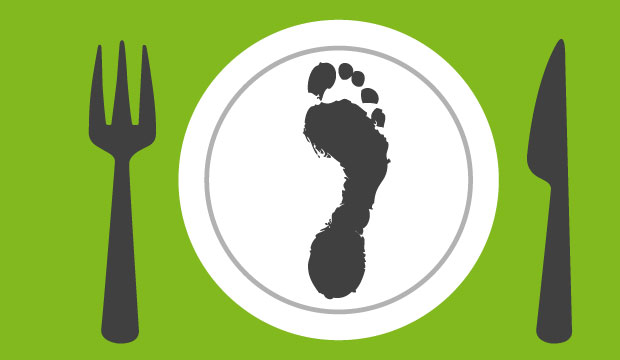
Food’s carbon footprint, or foodprint, is the greenhouse gas emissions produced by growing, rearing, farming, processing, transporting, storing, cooking and disposing of the food you eat.
In the US, each household produces 48 tons of greenhouse gases. Transport, housing and food have the three largest carbon footprints. Food produces about 8 tons of emissions per household, or about 17% of the total. Worldwide, new reports suggest that livestock agriculture produces around a half of all man-made emissions.
Changing the foods that you eat can have a big impact on your carbon footprint. And reduce pollution, preserve the environment and slow global warming. Many of these changes will also save you money, improve your health and even keep you fit! Have a browse of How You Can Fight Climate Change for more ideas on taking action to save our beautiful planet.
Carbon Footprint Ranking of Food
The following table shows the greenhouse gas emissions produced by one kilo of each food. It includes all the emissions produced on the farm, in the factory, on the road, in the shop and in your home. It also shows how many miles you need to drive to produce that many greenhouse gases. For example, you need to drive 63 miles to produce the same emissions as eating one kilogram of beef.
Meat, cheese and eggs have the highest carbon footprint. Fruit, vegetables, beans and nuts have much lower carbon footprints. If you move towards a mainly vegetarian diet, you can have a large impact on your personal carbon footprint.
| Rank | Food | CO2 Kilos Equivalent | Car Miles Equivalent |
| 1 | Lamb | 39.2 | 91 |
| 2 | Beef | 27.0 | 63 |
| 3 | Cheese | 13.5 | 31 |
| 4 | Pork | 12.1 | 28 |
| 5 | Turkey | 10.9 | 25 |
| 6 | Chicken | 6.9 | 16 |
| 7 | Tuna | 6.1 | 14 |
| 8 | Eggs | 4.8 | 11 |
| 9 | Potatoes | 2.9 | 7 |
| 10 | Rice | 2.7 | 6 |
| 11 | Nuts | 2.3 | 5 |
| 12 | Beans/tofu | 2.0 | 4.5 |
| 13 | Vegetables | 2.0 | 4.5 |
| 14 | Milk | 1.9 | 4 |
| 15 | Fruit | 1.1 | 2.5 |
| 16 | Lentils | 0.9 | 2 |
Figures from the Environmental Working Group’s Meat Eater’s Guide and the EPA’s Guide to Passenger Vehicle Emissions.
Top Tips for Reducing your Carbon Footprint
1. Food’s Carbon Footprint: Eat vegetarian
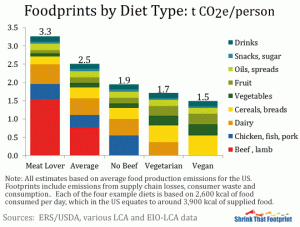
Livestock farming produces from 20% to 50% of all man-made greenhouse gas emissions.
Shrink That Footprint’s chart shows that a meat lover has the highest carbon footprint at 3.3 tons of greenhouse gas emissions. A vegan diet has the lowest carbon footprint at just 1.5 tons CO2e (Carbon Dioxide Equivalent). You can reduce your foodprint by a quarter just by cutting down on red meats such as beef and lamb.
The carbon footprint of a vegetarian diet is about half that of a meat-lover’s diet.
It’s good for the animals too! Most animals are raised in factory farms where they live in horrific conditions. The factory workers also suffer from poor wages and dangerous working practices. Factory farms are heavy polluters of the air and ground. The meat they produce is also polluted with superbugs. Over 3.5 million people get sick from eating ‘dirty’ meat every year in the US.
It’s good for you too! Vegetarians live longer than meat-eaters. Vegetarians are slimmer than meat-eaters. Vegetarians have a lower risk of getting heart disease, high blood pressure, diabetes and cancer.
Browse Healthy Eating for more tips on a healthy, vegetarian diet.
- use proteins such as beans, lentils, tofu, tempeh and quorn to replace meat, cheese and eggs
- make sure you are getting enough iron and zinc by including lots of wholegrains, beans and a variety of vegetables
- invest in some vegetarian or vegan cookery books and have fun experimenting
- don’t rely on vegetarian processed foods.
Green Fact: 70% of the deforestation of the Amazon is to provide land for cattle ranches.
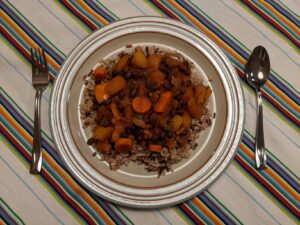 2. Food’s Carbon Footprint: Bring back home-cooking
2. Food’s Carbon Footprint: Bring back home-cooking
Take control of the food you eat and base your meals on natural foods such as vegetables, fruits, whole-grains, beans and lentils with a little meat and fish:
- discover the simple pleasures of preparing and eating your own meals
- check out Vegetarian Recipes for lots of tasty ideas
- improve the health of you and your family – see more at Vegetarian Nutrition
- plan your meals ahead to reduce wastage
- save your leftovers and create a new meal with them
- if you can, make your own compost with uncooked vegetable scraps.
Check out Why Food Waste is a Good Thing! for more tips on how to reduce food wastage.
Green Fact: British and American households throw out a THIRD of the food that they buy!
3. Food’s Carbon Footprint: Cooking smartly
Did you know that a gas oven only uses 6% of its energy to cook? And an electric oven is not much better at 12%. If you use the oven on a warm day, you will also heat up the room and need to turn on a fan or air-conditioning. In fact, the most efficient cooking method is simmering on the stove-top.
- eat more raw foods that do not need cooking
- use the stove-top whenever possible
- next best is the microwave as it uses 50% less energy than an oven
- use the oven sparingly and smartly…reduce preheating, cook multiple foods, turn off early
- use electric kettles to boil water for cooking or drinking.
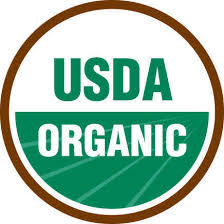
4. Food’s Carbon Footprint: Eat Organic
Organic farming methods for both crops and animals have a much lower impact on the environment than conventional methods. Organic-certified farms must use natural methods for soil fertilisation, weed prevention and pest control. Antibiotics and growth hormones cannot be used to raise food animals, and there are standards of care which prevent cruelty to livestock. Genetically-modified and irradiated foods cannot be labelled organic and its better to avoid these processes which are not proven to be safe for us or the food chain.
Organic food is better for you too! Crops are grown in fertile soils that are full of nutrients – and these end up in your food and then in you. Livestock are able to roam the fields and eat their natural food – grass – rather than being force-fed corn. And this leads to a much less fatty meat that keeps your heart healthier.
Find out which fruits and vegetables are the worst and least contaminated with pesticides at Eat Organic, Drink Clean.
Green Fact: poor soil management costs the US $10 billion every year in lowered yields and lost nutrients.
5. Food’s Carbon Footprint: Save water
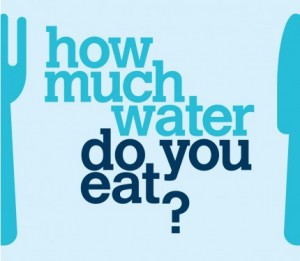
Water is a precious resource that is becoming scarce in many countries such as Egypt, Mexico, Pakistan and Australia. And even if you do not live in one of these arid countries, you may be wearing or using goods and consuming foods produced in those places, thus contributing to their water debt. One of the major impacts we can have personally is by moving towards a vegetarian diet, which requires about half the water to produce than a meat-based diet. It also makes sense to reduce your personal water consumption by practicing water conservation in your daily life:
- eat a mainly vegetarian diet
- only use the dishwasher when full and select the program with low water usage
- if you wash-up by hand, start with a half-empty bowl and rinse the dishes back into your washing-up water rather than down the plughole
- use filtered tap water for drinking rather than energy and water-intensive bottled water
- take a shower rather than a bath and shower less often in less time!
- turn off the taps when brushing your teeth or washing or shaving
- clean your clothes less often and only wash full loads
- use ‘grey’ water to water your garden and house-plants.
Green Fact: the average Australian uses around 30,000 gallons of water per year around the home for drinking, washing, cooking, laundry etc but it takes around 400,000 gallons of water to produce the crops that feed and clothe them!
6. Food’s Carbon Footprint: Shop wisely
Think before you buy! Do you actually need this? Can you find a better, greener alternative?
- use a shopping list to avoid those impulse purchases
- avoid products that use lots of packaging
- buy in bulk to save money and reduce packaging
- check the label – a long list of ingredients generally means a heavily processed item with a high carbon footprint
- frozen food has the highest carbon footprint, followed by canned, plastic, glass, then cardboard
- and please don’t buy bottled water.
Green Fact: around 5,000 million pounds weight of plastic water bottles were produced in 2005 and only 20% were recycled. That’s a lot of waste in our landfills, on our streets and in our oceans.

7. Food’s Carbon Footprint: Shop local
Think about where you do your shopping. Do you drive to the local shop when you need something – why not walk? Does your supermarket support green initiativesand offer local, organic foods? Is there a nearby farmer’s market or co-op you can use? And think about where food comes from – if it is from the other side of the world, it will have a high transportation footprint.
A weekly food shop is a habit many of us follow…but is it an efficient use of time and resources? The average household throws away a third of the food that they buy as it is so easy to over-shop in those tempting supermarkets. After all, they are designed to sell us as much as possible, whether we need it or not. What about shopping in bulk every other week for non-perishable goods, and using your local shops for fresh foods?
Green fact – around 11% of the greenhouse emissions involved in food production are linked to food transportation.
8. Food’s Carbon Footprint: Reuse and recycle
Think creatively about how you can reuse and recycle. Glass jars and plastic containers make great storage options. Take your own shopping bags and say no to plastic bags. Take reusable produce bags for your fruit and vegetables – if you use the ethylene-absorbing bags it prolongs shelf-life too. And when you can’t reuse, make sure you recycle whatever you can.
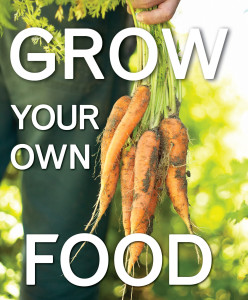 9. Food’s Carbon Footprint: Grow your own food
9. Food’s Carbon Footprint: Grow your own food
A great way to save money, get fit and reduce your carbon footprint is to grow your own fruit and vegetables. If you have a garden or backyard, then it is a fun way to make sure your family has access to affordable, healthy, pesticide-free food. And even if you live in an apartment, what about using your balcony or even the communal outside areas? Failing that, there is a growing movement (ha!) in Australia and The States to set up community gardens.
Food’s Carbon Footprint – how to reduce your carbon footprint by eating healthily.
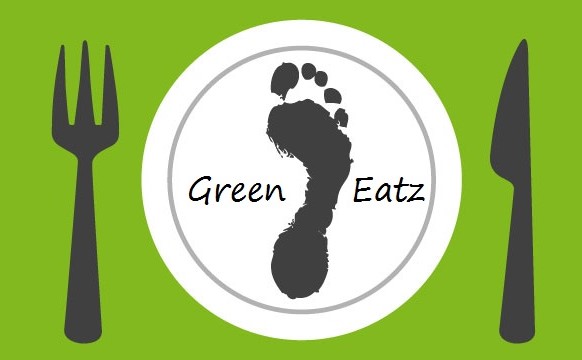

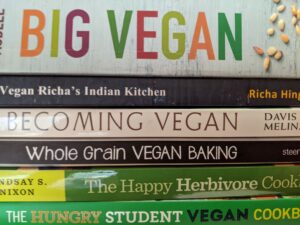
What about insect meat, what is the foodprint of insect powder or whole insects, such as crickets, mealworms, escamole, locusts, and so forth?
Insects vary in nutrient content, but most edible insects are the one of the most dense natural packets of essential nutrients that we have in the world. No wonder 2 billion of the world’s human population consume insects deliberately as part of their regular diet.
Are these data available?
Hey Florence – this scientific study concludes that insect production is not currently efficient enough to have much impact on the carbon footprint of the European diet.
This is very interesting to read!
Thanks for providing a list of the different types of food which cause the most carbon, and providing ways to reduce that!
I’m always looking for new ways to better what I do, and offset my emissions, so this is very helpful!
Hi Jane,
Great article! Just wondering how you worked out the carbon footprint of different meats, as I couldn’t see these figures reflected in the source. Thanks 🙂
What is the assumed gas mileage here!? I’m calculating about 20MPG (Gasoline not Deiseal) using:
CO2 Emissions from a gallon of gasoline: 8,887 grams CO2/ gallon
CO2 Emissions from a gallon of diesel: 10,180 grams CO2/ gallon
Also if you convert this into miles properly, you’ll realize the “CO2 Kilos Equivalent” is really a “CO2 conversion factor” that works for both standards of measure. ie. 1 lb of Beef = 27 lbs of CO2.
Hey John, yes the figures are for an average passenger vehicle which is quoted by the EPA to have a fuel economy of 22.0 mpg. See more at https://www.epa.gov/greenvehicles/greenhouse-gas-emissions-typical-passenger-vehicle#driving
Same concern for a generic category such as “fruit”. Hard to imagine a kilo of raspberry from California (fumigated ground, plastic mulch, plastic tunnels, numerous passes by spray rigs, packed in non-recyclable plastic, cooled for days, shipped by refrigerated trucks all over the country, cooled in the store) is anything close to fruit produced more locally/regionally. The variation among the different fruits and vegetables is so large as to make your number meaningless. The devil is in the details.
ok so I can eat 500g of beef a week if I forgo one of my twice a year visit to my parents. They’re in luck because I’ve been working from home for the last year….
I fully switched to soybean for protein. Soak overnight and pr. cook! It won’t form paste like lentils but spice and dress like sprouts. No gas problem! Suits my stomach well. Cheapest direct source of protein!!
I also reduced all items like toothpaste, detergent to minimum. Use cloth bag for shopping. Small car.
If your a meat eater or not, if the enviroment within you live in is a worry then you should try and individually do somtehing about it.
I chose a plant based diet because its the best thing to do for the planet. Look at the science there is no arguements only from people who have vested interestes.
Thanks for the information and opportunity. I’ll do my best to share it with everyone.
What IBS suffers . Sadly alot of vegan/veg protein replacement hurt my gut, plus some vegetables. I literally depends on eggs and chicken for protein. I have cut beef and pork. But I need a protein source that not hurt me. These are factors you need consider. Foods that may good for you are not good for others.
Have you tried red lentils? – these are soft on the digestive system and a very good source of protein.
I had problems eating beans when I first went vegan, but after a few months I felt fine.
Your gut will adapt to digest the food you give it.
Good luck!
Tofu, some lentils,edamames and canned beans are low fodmap vegan proteins if you want to try. (I have IBS too)
My son has IBS – we use tofu when he’s not too bad, and otherwise quinoa which is a high protein food with no gluten or yeast etc. Then we use nuts such as cashew and almond too.
If you want to reduce your need for animal protein, one way is combining plant proteins that are incomplete in different ways so that when you digest them together they add up to a high-quality protein. But, if you really need to top it up with an egg, that’s OK! You have the same right as any living creature to use what’s needed for you to exist and be healthy.
Its not necessary to combine plant proteins in one meal to get all the amino acids you need. As long as you eat a variety of plant proteins, you will be fine. I don’t agree with the sentiment either – humans can exist fine on a plant-based diet so why exploit and kill animals?!
Humans are genetically designed to digest plant proteins. That’s why our digestive tract is so long. Even a person who consumes meat on a regular basis consumes the majority of their protein from a plant based source. If anything, you’re probably just psyching yourself out on “what’s not good for you” because you’re not fully committed to becoming plant based or vegetarian.
Thank you for good information.
Thanks. Is there a data base where I can look up specific items? Like normal burger from McDonald’s versus a veggie burger from the same place?
Sorry, I don’t know of one. But here’s an article that compares the Impossible Burger with a meat burger – yes, you’ve guessed it, the veg burger has a much much lower carbon and water footprint 🙂
Many of the points i am in total agreement with, recycling in particular. Other things like walking to the shops. Good common sense, but not many people really embrace this logic it seems.
So what happens if we take an average middle class western vegan, living in a cold climate. who consumes daily almond milk and other stuff with a big marketed “V” slapped on the side of plastic containers, imported from thousands of miles away. Which they then drive to pick up from the supermarket. Then they decide to book another third world back packing holiday, which involves four aeroplane tickets…. Then from their new iPhone announce to the world #save the planet. Blah blah blah. Yet it seems they are embraced in vegan circles, because of their pro vegan t-shirt.
Now i know a lot of vegans who do this all the time. I am certainly not against personal freedom of choice, veganism is just that, fair play. But wouldn’t it be interesting to look at individual carbon footprints, rather than cherry picking data on potatoes?
No amount of Dr Gregor or mental McDougal is going to wash away the pomposity of most people who claim to really care or know about polution. Activism starts with ones one actions does it not? Reading your article i would expect you to agree.
Ethics is also important to consider here, do people assume that the billions of animals poisened, injured and killed within monocrop production do not exist? Just because one doesnt eat meat, it is incredibly naive to think/pretend they are not causing any suffering by this choice.
Huge amounts of rainforest deforestation is caused by sugar plantations. Think about, coffee, chocolate and any number of other consumables that utilise human slavery. The list goes on and on. I have NEVER heard a vegan ask, when handed a slice of sickly vegan cake at a fundraiser “is this ethicaly sourced sugar”. Its this sort of hypocrisy that puts many educated types off veganism. Its not that they cant eat steak twice a week.
I do know of a very nice and highly acclaimed vegan eco warrior. He doesnt drive, hand picks seasonal vegetables, lives in a treehouse, with the odd solar panel and refuses to travel on fossil fuels. We all have REAL respect for his lifestyle. Food for thought for sure.
The whole concept of a vegan diet with relation to suffering is minimizing suffering to the greatest possible extent. If you really care about all the animals killed in crop production, you should know that it takes 7x the grain to produce 1 lb of beef than it does to produce 1 lb of grain. Not only are the livestock slaughtered in this scenario, but also they are fed grains that are harvested using methods that also kill (small) animals.
As for deforestation, the majority of deforestation that occurs is either to clear space for livestock, or to clear space to grow livestock feed. So if you claim to care so much about the environment, and you’re saying that vegans don’t do enough, then not only should you be going vegan, but you should also live on a farm and grow all of your own food. Since that is clearly not an option for the vast majority of normal people, why don’t you cut your emission in half by going vegan instead of complaining that veganism isn’t good enough? It sounds like you’re doing very little to change your actions, and using the excuse of “veganism isn’t perfect” to justify it. Just some food for thought 🙂
Hi Frederico DeManchafiniola
I have been living in many countries in my life so far. (I hate moving >_< but I like learning.)
I appreciate your unbiased outline of how we can help our environment.
I do feel we need to look at our "overall" Carbon Footprint. For example, the house we live, the car we drive, the clothing we wear, the food we eat…
Our earth was doing well for millions of years until the last 200 years of the industrial age.
Therefore, It is important to look back on what our ancestors do to make our planet happy.
Good points. I think as individuals we all must take our own responsibility but definitely no no one is in any position to tell others how to live – both omnivore and herbivore. We all must find a balance of living that also doesn’t suck the life out of life. I think the messages should be about reckoning one’s one offset. If I choose to take a flight for example what am I going to do to try and offset my own behaviour and contribution to global warming. I can’t forsee never travelling abroad. But as with my saving habit (saving up the money to travel) I now also engage in my carbon offseting habit to allow me the luxury to make that journey abroad.
This is amazing and insightful thank you for providing stats to reduce global footprints!!
Interesting point, but note that at the bottom of the chart provided it states that these are the emissions for each person on a 2600 cal diet. So, calories were taken in to account here.
Calories could not have been taken into account in the chart of CO2 / food. That chart is likely CO2 / 100g of food. You want a chart of CO2 / calorie. A good example is cheese and milk. The chart has cheese having seven times the CO2 of milk. But cheese is really just milk with much of the water taken out plus a bit of processing. On a chart of CO2 / calorie, cheese only produces about 20% more CO2 than milk per calorie.
Hey ‘Rational Thinker’
Way to cherry pick your quotes to try to back up your claims, except you had to cite the quote so maybe you were just hoping nobody would take the time to read the source?
Well I did.
So here’s some quotes from your own study;
“The largest environmental benefits across indicators were seen in those diets which most reduced the amount of animal-based foods, such as vegan (first place in terms of benefits for two environmental indicators), vegetarian (first place for one indicator), and pescatarian (second and third place for two indicators).”
And another great one;
“Our resulting median impacts produced internally consistent and plausible trends; for example, vegan diets having greater reductions in GHG emissions than vegetarian; greater benefits from reducing meat and dairy consumption compared to meat alone; and replacing meat with dairy having little benefit.”
Energy in versus energy out plant foods will always win, not to mention the ethical implications of slaughtering animals without necessity and the health consequences of an animal based diet.
Use that rational thinking you claim to have and come to the only logically consistent and rational conclusion we can and go vegan.
Hey ‘Rational Thinker’
Way to cherry pick your quotes to try to back up your claims, except you had to cite the quote so maybe you were just hoping nobody would take the time to read the source?
Well I did.
So here’s some quotes from your own study;
“The largest environmental benefits across indicators were seen in those diets which most reduced the amount of animal-based foods, such as vegan (first place in terms of benefits for two environmental indicators), vegetarian (first place for one indicator), and pescatarian (second and third place for two indicators).”
And another great one;
“Our resulting median impacts produced internally consistent and plausible trends; for example, vegan diets having greater reductions in GHG emissions than vegetarian; greater benefits from reducing meat and dairy consumption compared to meat alone; and replacing meat with dairy having little benefit.”
Energy in versus energy out plant foods will always win, not to mention the ethical implications of slaughtering animals without necessity and the health consequences of an animal based diet.
Use that rational thinking you claim to have and come to the only logically consistent and rational conclusion we can and go vegan.
The idea that you need to eat equal amounts of calories in vegetables as a meat eater does not seem valid. The reason why meat eaters have more likelihood of obeciry is precisely because they consume too many calories.
Either way, you do not need to be a vegan or even an absolute vegetarian. Eating chicken or fish two or three times per week and substituting the rest with eggs and other less carbon intense sources of calories/protein should reduce the carbon footprint substantially.
Assuming people can bring themselves to do this on a wider scale it would have a significant impact. I’ve not found it to be especially problematic or even difficult.
What would be helpful though is if CO2 cost was printed on every single consumer product. That would enable people to budget their emissions properly.
I admired that some vegan eats very healthy, they don’t eat any sweets.
Whereas others, enjoy deserts and tell people to be vegan because it is healthier to be vegan.?? Almost all the vegan protein bars in Canada and America are way to sweet. When I look at their sugar content, it is literally eating dessert!
I understand that some people only eat meats and hate vegetables.
So it all comes down to having a balance on our food choice.
Yep, many so-called health bars are full of sugar! Read more about sugar here.
Agree. The cost of CO2 printed would be helpful (just as calories and fat content are printed on food packaging)
Thanks for the great info!
Would be really useful to see a breakdown based on UDSA or other typical portion sizes. People will often eat 6 oz of meat but no-one is sitting down to 6 oz of cheese. Same for oily fish (anchovies) and salmon. I think the per kilo or per 50g of protein metrics we often see distort the effect of things like anchovies and cheese since they don’t reflect the way that people actually use these foods.
True – that would be helpful, maybe I’ll work on something in the future. Meanwhile, I’m thinking that a kilo of meat would probably feed about 4 people but a kilo of dried lentils around 10 people.